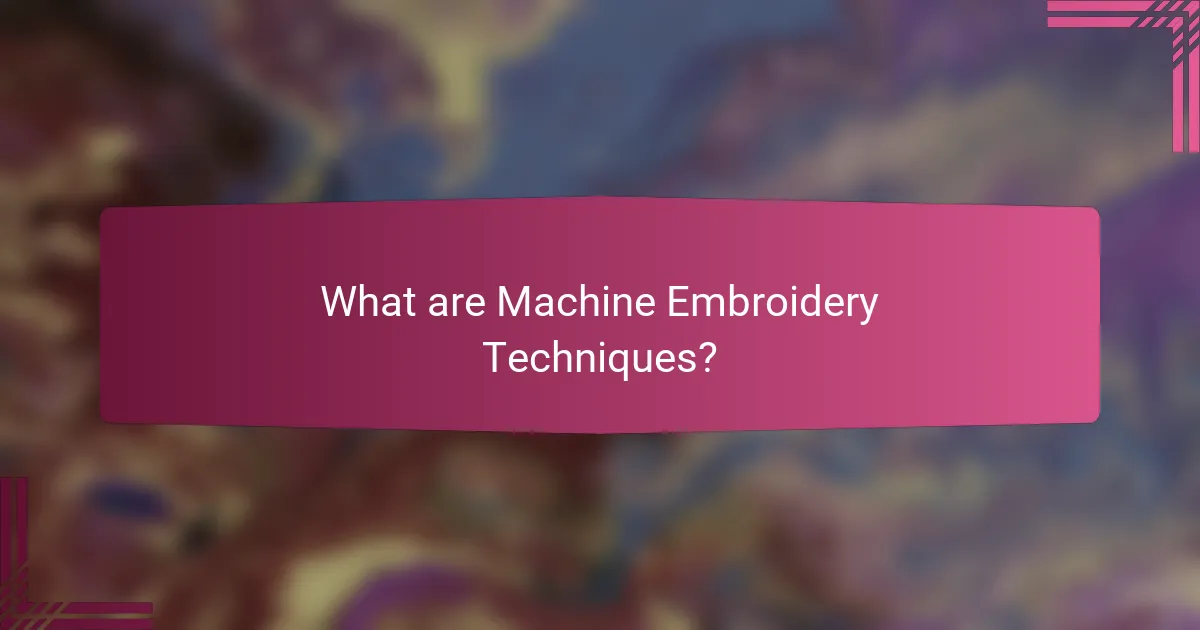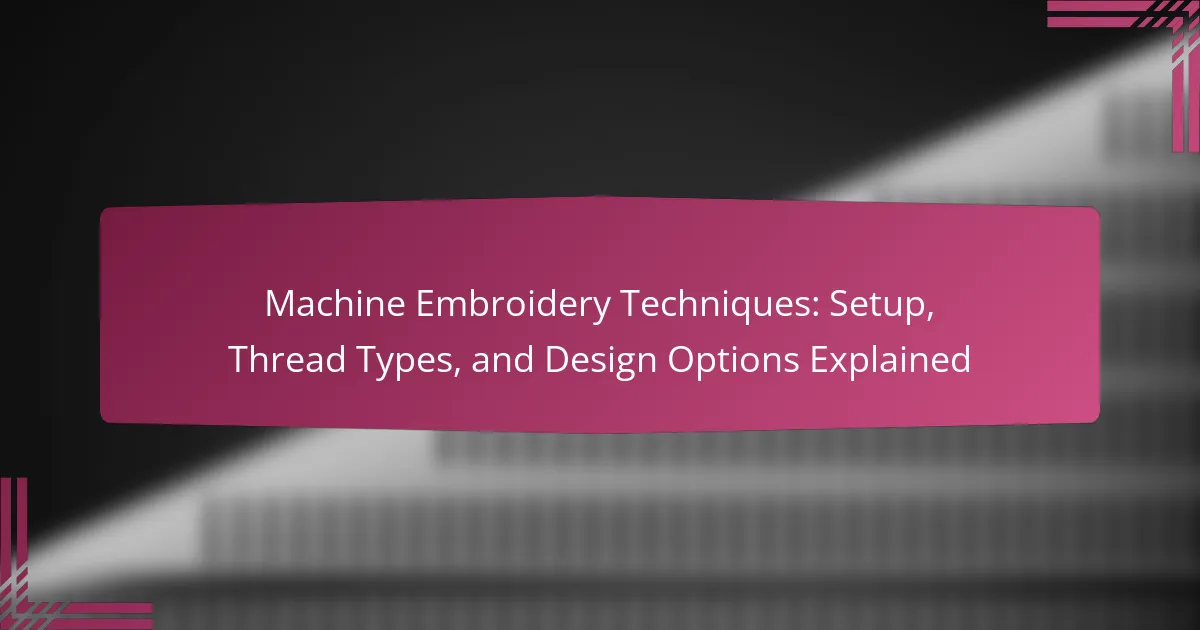
What are Machine Embroidery Techniques?
Machine embroidery techniques refer to the methods used to create designs on fabric using a sewing machine. These techniques include digitizing, which involves converting images into a format the machine can read. Additionally, there are various stitching methods such as satin stitch, fill stitch, and running stitch. Each method contributes to the overall texture and appearance of the embroidery. For instance, satin stitch creates a smooth, shiny finish, while fill stitch covers larger areas with thread. Machine embroidery techniques also utilize different thread types, which can affect the final look. Common thread types include rayon, polyester, and cotton, each offering unique properties. These techniques enable the production of intricate designs efficiently and consistently.
How do Machine Embroidery Techniques differ from traditional methods?
Machine embroidery techniques differ from traditional methods primarily in their automation and precision. Machine embroidery uses computerized systems to control stitching patterns and designs. This results in faster production times compared to hand embroidery, which is labor-intensive.
Additionally, machine embroidery allows for complex designs that may be difficult to achieve by hand. It employs a variety of thread types and colors with consistent tension, ensuring high-quality results. Traditional methods rely on manual skills and may vary in quality due to human error.
The use of stabilizers in machine embroidery also enhances the fabric’s support during stitching, which is less common in hand embroidery. Overall, machine embroidery is efficient, consistent, and capable of producing intricate designs with less physical effort than traditional techniques.
What are the key features of machine embroidery?
Machine embroidery is a process that uses a sewing machine to create designs on fabric. Key features include precision stitching, which allows for intricate patterns and details. The use of computerized designs enhances accuracy and repeatability. Various thread types can be employed, including polyester and rayon, each offering different finishes. Machine embroidery supports multiple colors, enabling complex designs. It also provides durability, as embroidered designs tend to withstand washing and wear. Additionally, the setup of machine embroidery can be customized for different fabric types and thicknesses. This versatility makes it suitable for a wide range of applications, from apparel to home decor.
How has technology influenced machine embroidery techniques?
Technology has significantly influenced machine embroidery techniques by enhancing precision and efficiency. Modern embroidery machines now utilize computerized systems for design and execution. This advancement allows for intricate patterns to be embroidered with high accuracy. Additionally, software programs enable users to create and modify designs easily. The introduction of multi-needle machines has increased production speed. Moreover, advancements in thread types have improved durability and color variety. Digital file formats allow for quick transfer of designs to machines. Overall, technology has revolutionized machine embroidery, making it more accessible and versatile.
What are the essential setups for machine embroidery?
The essential setups for machine embroidery include the embroidery machine, stabilizer, thread, and design software. An embroidery machine is necessary for executing the stitching process. A stabilizer supports the fabric during embroidery, preventing distortion. The choice of thread affects the quality and appearance of the finished design. Design software allows users to create and modify embroidery patterns. Proper setup ensures smooth operation and high-quality results. Each component plays a critical role in the embroidery process. For instance, using the right stabilizer can reduce fabric puckering and improve the final output.
How do you prepare a machine for embroidery?
To prepare a machine for embroidery, first ensure the machine is clean and free of dust. Next, check that the needle is appropriate for the fabric and replace it if necessary. Then, thread the machine according to the manufacturer’s instructions, ensuring it is properly tensioned. Select the correct embroidery design and transfer it to the machine. Place the fabric in an embroidery hoop, making sure it is taut and secure. Finally, run a test stitch on a scrap piece of fabric to confirm settings and adjust if needed. These steps ensure optimal performance and quality in the embroidery process.
What tools and materials are necessary for machine embroidery setup?
The necessary tools and materials for machine embroidery setup include an embroidery machine, embroidery thread, stabilizers, and fabric. An embroidery machine is essential for stitching designs onto fabric. Embroidery thread is specifically designed for durability and sheen in finished projects. Stabilizers provide support to the fabric during the embroidery process, preventing distortion. Various types of stabilizers, such as tear-away, cut-away, and water-soluble, can be used depending on the fabric and design. Fabric choice is crucial, as different materials require different handling and stabilizers. Additionally, tools like scissors, a hoop, and software for design digitization may also be needed. These components collectively ensure a successful machine embroidery experience.
Why is thread selection important in machine embroidery?
Thread selection is crucial in machine embroidery because it directly affects the quality and durability of the finished product. The right thread can enhance the design’s appearance and ensure proper tension during stitching. Different materials, such as polyester or rayon, offer unique properties that influence color vibrancy and sheen. Additionally, thread weight impacts the stitch density and overall design detail. Using the appropriate thread type reduces the risk of breakage or fraying, which can lead to project failure. Proper thread selection also ensures compatibility with the fabric, preventing damage or distortion. In summary, thread selection is vital for achieving professional results in machine embroidery.
What are the different types of threads used in machine embroidery?
The different types of threads used in machine embroidery include polyester, rayon, cotton, and metallic threads. Polyester threads are popular due to their strength and colorfastness. Rayon threads provide a shiny finish and are often used for decorative stitching. Cotton threads are favored for their natural look and feel, making them suitable for quilting. Metallic threads add sparkle and shine, enhancing the visual appeal of designs. Each thread type serves specific purposes based on desired outcomes in machine embroidery projects.
How do thread types affect the final embroidery outcome?
Thread types significantly affect the final embroidery outcome. Different thread materials, such as polyester, rayon, and cotton, offer varied sheen and texture. Polyester threads are durable and provide a glossy finish, enhancing visual appeal. Rayon threads are softer and have a vibrant color, making them ideal for detailed designs. Cotton threads, while less shiny, offer a matte finish that suits traditional styles. The thickness of the thread also influences stitch density and overall design clarity. For example, thicker threads can create bold outlines, while finer threads are better for intricate details. Choosing the right thread type ensures the embroidery matches the intended design aesthetic and functional requirements.
